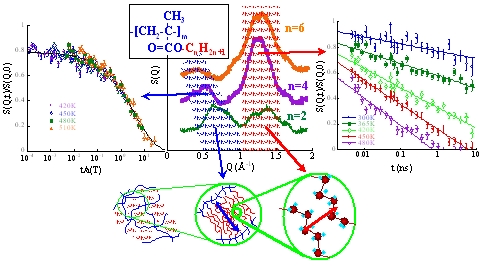Rechercher
Accueil > La Recherche > Axes & Equipes > Matière Molle & Verres > Equipe : Physique des Verres > Thème : Structure, vibration, relaxations dans les systèmes désordonnés
Structure and Dynamics in Nanoconfined Self-Assembled Polymers
publié le , mis à jour le
Involved researchers : A.C. Genix
(collaboration : J. Colmenero, A. Arbe, San Sebastian –SPAIN)
We are exploiting the selectivity of neutron scattering combined with isotopic substitution to study the structure and dynamics of poly(n-alkyl methacrylates). In these polymers, the alkyl side groups of different repeat-units seem to self-assemble forming nanodomains (called polyethylene (PE)-like). Moreover, the higher order PnMAs show two distinct glass-transitions which presumably correspond to the freezing of motions within the alkyl nanodomain and of the main-chain dynamics.
Our diffraction data nicely demonstrate the nanosegregation of main chains and side groups. Moreover, by Neutron Spin Echo (NSE) we have separately followed the structural relaxation of both subsystems. Contrary to the standard behaviour found at the main-chain level, the correlations involving long side groups within the alkyl nanodomains relax through an exotic logarithmic decay - probably a signature of nano-confinement of the side-groups by the more rigid main chains.









